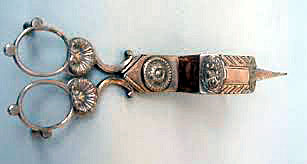
QUESTIONS: I’ve always loved the look and variety of antique perfume bottles. Since most of these are small, they’re often overlooked in the cases of smalls at flea markets and antique shows. It takes determination to seek them out. I’d love to know more about the history of perfumes, as well as some history about perfume containers.
ANSWERS: The Egyptians were the first to use perfume, but not for personal, everyday use. They utilized scents to celebrate prayers and religious ceremony by burning essential oils, resin, and perfumed unguents.
 Early civilizations used perfumes—usually aromatic resins and oils, burned to release an aroma—to scent the air. The Latin term “per fumum” means “through smoke” which is where the name ‘Perfume’ came from.
Early civilizations used perfumes—usually aromatic resins and oils, burned to release an aroma—to scent the air. The Latin term “per fumum” means “through smoke” which is where the name ‘Perfume’ came from.
In ancient Greece, common people began using perfumes as part of their daily hygiene. The ancient Egyptians traded spices, aromas, and resins abundant in Egypt, as well as those imported from the Middle East, Arabia and India. Myrrh and incense made up some of the main ingredients of the scents of the time.
 For much of recorded history, perfumes were only available to aristocrats and the wealthy. By the late 18th century, perfumes were in common use among the upper classes, and it didn’t take long to become de rigueur for the fashionable set, both male and female. In 1856, Harper’s Monthly railed against overuse of scents by men, calling the practice "foppish, effeminate, a waste of money, and a foolish gratification of sensual appetite."
For much of recorded history, perfumes were only available to aristocrats and the wealthy. By the late 18th century, perfumes were in common use among the upper classes, and it didn’t take long to become de rigueur for the fashionable set, both male and female. In 1856, Harper’s Monthly railed against overuse of scents by men, calling the practice "foppish, effeminate, a waste of money, and a foolish gratification of sensual appetite."
 After the Civil War, a variety of cheap perfumes came on the market. Such labels as Little Tot, American Girl, Boudoir, Bridal Bouquet, Duchess Ladies, Sensible, Home Sweet Home, Bow Wow, and Happy Family were common. By far the most popular, however, was the Hoyt's 5-Center, sold over general store counters everywhere. Hoyt's became the great odor of the common man. Like most other cheap brands it had a faint aroma of rose and honeysuckle. And while lavender and violet were popular with upper class women.
After the Civil War, a variety of cheap perfumes came on the market. Such labels as Little Tot, American Girl, Boudoir, Bridal Bouquet, Duchess Ladies, Sensible, Home Sweet Home, Bow Wow, and Happy Family were common. By far the most popular, however, was the Hoyt's 5-Center, sold over general store counters everywhere. Hoyt's became the great odor of the common man. Like most other cheap brands it had a faint aroma of rose and honeysuckle. And while lavender and violet were popular with upper class women.
Queen Victoria’s preference was for simple, fresh and understated fragrances. Following Victoria’s lead, English women began wearing delicate scents such as lavender, jasmine, bergamot and lemon. Violet became particularly popular, as well as herbaceous notes of thyme, clove and rosemary.
Besides flowers, aromatic woods, odorous spices, grasses and herbs, animal substances were primary ingredients of perfumes. Ambergris was a secretion of the sperm whale that net only mellowed other scents but gave them greater longevity. The most lasting of odors came from the musk deer of China and Tibet. One part of musk was said to scent over 3,000 parts of "inodorous powder" with an intoxicating aroma that impregnated any surface with which it came in contact.

 Given the nature of perfume, from the confidence it gives its wearer to the indescribable effect it sometimes has on its very targeted audience, it’s not surprising that perfume has long been kept in bottles whose shapes seem to echo the mysterious properties of the fluids inside them. Whether it’s a slender phial, a tiny tear-shaped lachrymatory, or a round, flat-sided ampullae, perfume bottles are designed to contain magic, which is only unleashed when a woman opens the bottle and applies a drop or two of the precious liquid to her body.
Given the nature of perfume, from the confidence it gives its wearer to the indescribable effect it sometimes has on its very targeted audience, it’s not surprising that perfume has long been kept in bottles whose shapes seem to echo the mysterious properties of the fluids inside them. Whether it’s a slender phial, a tiny tear-shaped lachrymatory, or a round, flat-sided ampullae, perfume bottles are designed to contain magic, which is only unleashed when a woman opens the bottle and applies a drop or two of the precious liquid to her body.
The earliest examples of perfume bottles come from Ancient Egypt, initially crafted from clay or wood. As the popularity of perfume spread across cultures, artisans created more ornate designs. The Romans hollowed out precious stones or blew magnificent glass bottles to hold their fragrances, while the ancient Greeks used terracotta sculpted into animal forms and shells. By the late 18th century, perfume containers came in a variety of materials, such as porcelain, silver, copper and white glass in various shapes influenced by artistic movements of the time. Enamel became popular as a base to hand-paint detailed pastoral scenes.

 As luscious as perfume smells, so were the shapes and designs of the bottles that contained it. Some were small enough for a woman to wear on a chain around her neck, in which case, the bottle became a piece of jewelry. Glassblowers in Britain, Bohemia, Germany, and France made perfume bottles throughout the 19th century. U.S. glass manufacturers such as the New England Glass Company and the Boston & Sandwich Glass Company also made perfume bottles during that time. Some of these were hexagonal and opaque—white, blue, and green were common colors—with knobby, pineapple-shaped stoppers.
As luscious as perfume smells, so were the shapes and designs of the bottles that contained it. Some were small enough for a woman to wear on a chain around her neck, in which case, the bottle became a piece of jewelry. Glassblowers in Britain, Bohemia, Germany, and France made perfume bottles throughout the 19th century. U.S. glass manufacturers such as the New England Glass Company and the Boston & Sandwich Glass Company also made perfume bottles during that time. Some of these were hexagonal and opaque—white, blue, and green were common colors—with knobby, pineapple-shaped stoppers.
 Fashionable Victorian women revived the use of the vinaigrette filled with a variety of delightfully sniffable scents. They also developed a preference for French labels on their dressing table bottles. The allure and snob appeal of French fragrances swept the perfume industry until even the down-to-earth Sears & Roebuck catalog succumbed with terms such as parfums, odeurs , and flacons. A typical 1905 ad offered: "Our Special Violette France Perfume, put up in magnificent 2-ounce cut glass stoppered bottle, for only 60 cents.”
Fashionable Victorian women revived the use of the vinaigrette filled with a variety of delightfully sniffable scents. They also developed a preference for French labels on their dressing table bottles. The allure and snob appeal of French fragrances swept the perfume industry until even the down-to-earth Sears & Roebuck catalog succumbed with terms such as parfums, odeurs , and flacons. A typical 1905 ad offered: "Our Special Violette France Perfume, put up in magnificent 2-ounce cut glass stoppered bottle, for only 60 cents.”
 Beginning around 1890, artisans and glass factories alike produced elaborate cut or blown glass perfume bottles with ornate caps, some of which had hinged silver stoppers and collars. Purse-sized conical bottles with very short necks and round stoppers were often decorated with gilt flower-and-leaf patterns.
Beginning around 1890, artisans and glass factories alike produced elaborate cut or blown glass perfume bottles with ornate caps, some of which had hinged silver stoppers and collars. Purse-sized conical bottles with very short necks and round stoppers were often decorated with gilt flower-and-leaf patterns.
The world of perfumes was then and is today one of mystery and magic. And the containers that house them are highly collectible.
To read more articles on antiques, please visit the Antiques Articles section of my Web site. And to stay up to the minute on antiques and collectibles, please join the over 30,000 readers by following my free online magazine, #TheAntiquesAlmanac. Learn more about the "Antiques of Christmas" in the 2021 Holiday Edition, online now. And to read daily posts about unique objects from the past and their histories, like the #Antiques and More Collection on Facebook.


















































